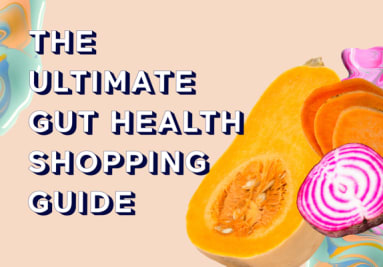If You Get Yeast Infections Before (Or During) Your Period, You're Not Alone

It’s that time of the month, and you are struggling with a yeast infection—AGAIN. For many women, this is a common situation. On top of the cramping and bleeding of their monthly cycle, they also get hit with symptoms of itching and burning in the vaginal area and a white clumpy discharge.
This problem can be incredibly frustrating and many patients are told they're simply "prone" to these infections. But as a functional medicine doctor who specializes in women's health, I give my patients actionable steps they can take to help prevent these infections from occurring, as well as explain why they might be happening in the first place.
What you need to know about recurring yeast infections.
The first thing you need to know about yeast infections is that we all have yeast in our bodies—in our GI tracts, our mouths, and yes, in our vaginas, too. A problem only really occurs when yeast grows out of control, which is what we call a yeast infection. Because we have yeast all over, we can also get a yeast infection in many areas of the body, including the skin, mouth, digestive system, and vaginal area.
So what are common causes of yeast infections? Yeast tends to proliferate when your blood sugar increases, your pH changes, or when there is a change in the microbiome (aka the good bacteria in your body decrease and yeast is able to take over).
Why yeast infections happen right before your period.
Researchers are not exactly sure why yeast infections are more common during a woman's period, but there are a few possible explanations. It may be from changes in the vaginal pH that can occur when there are shifts in hormones. When the acidity of the vaginal area changes, the levels of Lactobacillus bacteria decrease as well. High amounts of certain types of healthy Lactobacillus bacteria in the vaginal area prevent unhealthy levels of yeast. Another theory is that when estrogen levels increase1 in the body, yeast cells have an easier time growing and staying in the vaginal area. Estrogen levels increase in the body naturally during hormonal cycles and also when a woman is taking estrogen through birth control pills or hormone therapy.
How to prevent monthly recurring yeast infections.
When I have a patient who suffers from recurring yeast infections, I start by giving her a few action steps that will help balance blood sugar and keep vaginal pH within a healthy range. And it all starts with proper nutrition:
1. Work hard to avoid alcohol, simple sugars, and refined carbohydrates.
.
These foods cause elevations in blood sugar, and, unfortunately, right before and during a woman's period, it's easy to reach for foods like cookies, chocolate, and desserts. Eating these foods will only feed the yeast that can result in an infection. Focus on other ways to tame the cravings that can come with PMS by focusing on self-care. Even though you may not feel like it, this will actually help you feel much better. Take time for yourself by taking a yoga class, going for a walk, or curling up to read a good book. Make sure you are not skipping meals, and balance each meal with a good protein source, healthy fat, and high-fiber foods. This will help prevent the blood sugar crashes that can cause you to reach for yeast-feeding sugary foods
2. Don't douche!
You may be tempted to wash away the itchiness or try to keep things clean to prevent yeast overgrowth, but doing this is totally counterproductive. Douching can change the pH of your vaginal area and wash away the protective good bacteria, like Lactobacillus, resulting in a vicious cycle of itching and yeast infections. Rinsing your vaginal area with water is all that is needed.
3. Avoid unnecessary antibiotics.
Antibiotics will also kill off some of the healthy Lactobacillus, allowing the overgrowth of yeast in the body to occur. While antibiotics are lifesaving and often necessary, our country has a serious problem of prescribing antibiotics2 when they aren't really warranted, like in the case of viral infections like the common cold.
4. Consider taking a probiotic.
Some probiotics are specially formulated for women to contain high levels of Lactobacillus reuteri and Lactobacillus rhamnosus, two strains of bacteria that should be prevalent in the vaginal area3. When taken by mouth, these probiotics will affect the levels of good bacteria in the vaginal area and can decrease your risk of getting another yeast infection.
These changes are often enough to put a halt to the itching and yeast infections that can come with your monthly cycle. But if it is not, make sure to visit your doctor. He or she can examine you and determine if an antifungal medication is necessary to break this uncomfortable cycle.

Elizabeth Boham, M.D., M.S., R.D. is board certified in family medicine from Albany Medical College, and is Institute for Functional Medicine certified. She is also the medical director of The UltraWellness Center.
Boham lives in Valatie, NY, and lectures on a variety of topics, including women’s health and breast cancer prevention, insulin resistance, heart health, weight control, and allergies. She is on the faculty of the Institute for Functional Medicine.
